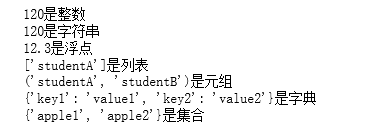python中判断变量的类型
2021-04-02 00:29
标签:字符 复制 tle oat 字典(dict) 补充 通过 print code python的数据类型有:数字(int)、浮点(float)、字符串(str),列表(list)、元组(tuple)、字典(dict)、集合(set) 一般通过以下方法进行判断: 1、isinstance(参数1,参数2) 描述:该函数用来判断一个变量(参数1)是否是已知的变量类型(参数2) 类似于type() 参数1:变量 参数2:可以是直接或间接类名、基本类型或者由它们组成的元组。 返回值: 如果对象的类型与参数二的类型(classinfo)相同则返回 True,否则返回 False 例子: 返回: 2、通过与已知类型的常量进行比较 例子: 返回: 补充: isinstance() 与 type() 区别: type() 不会认为子类是一种父类类型,不考虑继承关系。 isinstance() 会认为子类是一种父类类型,考虑继承关系。 如果要判断两个类型是否相同推荐使用 isinstance()。 python中判断变量的类型 标签:字符 复制 tle oat 字典(dict) 补充 通过 print code 原文地址:https://www.cnblogs.com/zhangqifeng2021/p/14605046.html
1 #判断变量类型的函数
2 def typeof(variate):
3 type=None
4 if isinstance(variate,int):
5 type = "int"
6 elif isinstance(variate,str):
7 type = "str"
8 elif isinstance(variate,float):
9 type = "float"
10 elif isinstance(variate,list):
11 type = "list"
12 elif isinstance(variate,tuple):
13 type = "tuple"
14 elif isinstance(variate,dict):
15 type = "dict"
16 elif isinstance(variate,set):
17 type = "set"
18 return type
19 # 返回变量类型
20 def getType(variate):
21 arr = {"int":"整数","float":"浮点","str":"字符串","list":"列表","tuple":"元组","dict":"字典","set":"集合"}
22 vartype = typeof(variate)
23 if not (vartype in arr):
24 return "未知类型"
25 return arr[vartype]
26
27 #判断变量是否为整数
28 money=120
29 print("{0}是{1}".format(money,getType(money)))
30 #判断变量是否为字符串
31 money="120"
32 print("{0}是{1}".format(money,getType(money)))
33 money=12.3
34 print("{0}是{1}".format(money,getType(money)))
35 #判断变量是否为列表
36 students=[‘studentA‘]
37 print("{0}是{1}".format(students,getType(students)))
38 #判断变量是否为元组
39 students=(‘studentA‘,‘studentB‘)
40 print("{0}是{1}".format(students,getType(students)))
41 #判断变量是否为字典
42 dictory={"key1":"value1","key2":"value2"}
43 print("{0}是{1}".format(dictory,getType(dictory)))
44 #判断变量是否为集合
45 apple={"apple1","apple2"}
46 print("{0}是{1}".format(apple,getType(apple)))


1 #判断变量类型的函数
2 def typeof(variate):
3 type1 = ""
4 if type(variate) == type(1):
5 type1 = "int"
6 elif type(variate) == type("str"):
7 type1 = "str"
8 elif type(variate) == type(12.3):
9 type1 = "float"
10 elif type(variate) == type([1]):
11 type1 = "list"
12 elif type(variate) == type(()):
13 type1 = "tuple"
14 elif type(variate) == type({"key1":"123"}):
15 type1 = "dict"
16 elif type(variate) == type({"key1"}):
17 type1 = "set"
18 return type1
19 # 返回变量类型
20 def getType(variate):
21 arr = {"int":"整数","float":"浮点","str":"字符串","list":"列表","tuple":"元组","dict":"字典","set":"集合"}
22 vartype = typeof(variate)
23 if not (vartype in arr):
24 return "未知类型"
25 return arr[vartype]
26
27 #判断变量是否为整数
28 money=120
29 print("{0}是{1}".format(money,getType(money)))
30 #判断变量是否为字符串
31 money="120"
32 print("{0}是{1}".format(money,getType(money)))
33 money=12.3
34 print("{0}是{1}".format(money,getType(money)))
35 #判断变量是否为列表
36 students=[‘studentA‘]
37 print("{0}是{1}".format(students,getType(students)))
38 #判断变量是否为元组
39 students=(‘studentA‘,‘studentB‘)
40 print("{0}是{1}".format(students,getType(students)))
41 #判断变量是否为字典
42 dictory={"key1":"value1","key2":"value2"}
43 print("{0}是{1}".format(dictory,getType(dictory)))
44 #判断变量是否为集合
45 apple={"apple1","apple2"}
46 print("{0}是{1}".format(apple,getType(apple)))

